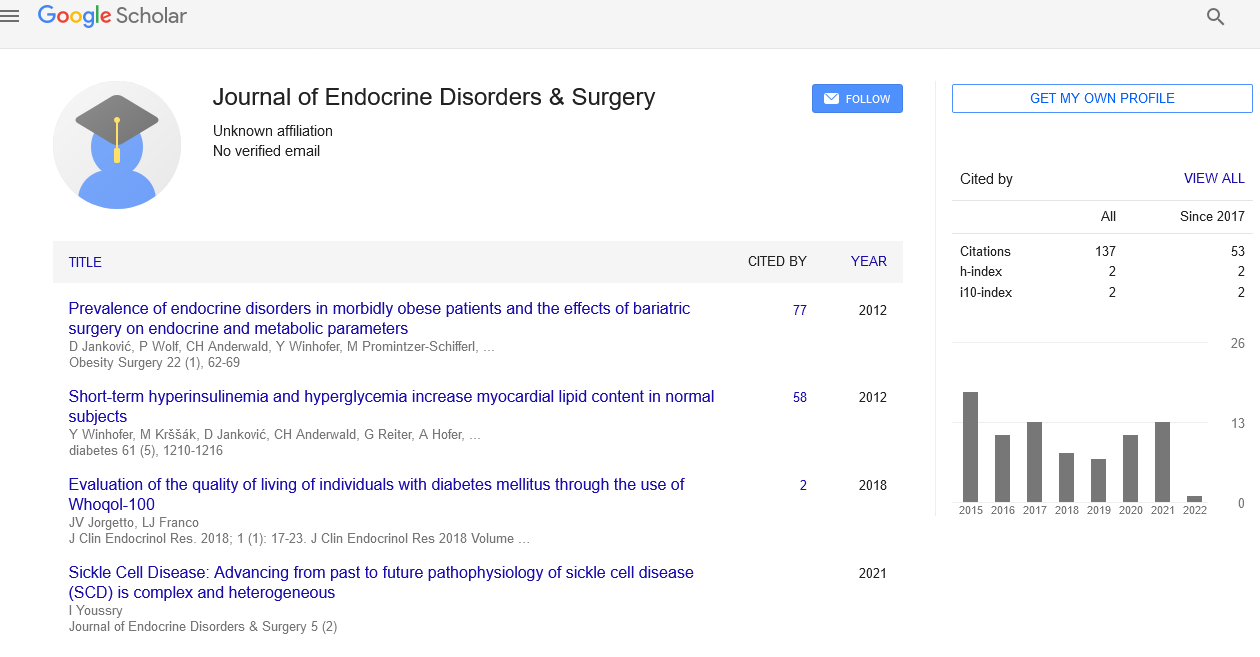Endocrine Neoplasia and Cancer
Received: 05-Jan-2023, Manuscript No. puljeds-23-6261; Editor assigned: 12-Jan-2023, Pre QC No. puljeds-23-6261 (PQ); Accepted Date: Jan 25, 2023; Reviewed: 17-Jan-2023 QC No. puljeds-23-6261 (Q); Revised: 20-Jan-2023, Manuscript No. puljeds-23-6261 (R); Published: 01-Feb-2023, DOI: 10.37532/puljeds.2023.7(1).05-06
Citation: Adams J. Endocrine Neoplasia and Cancer. J Endocr Disord Surg. 2023;7(1):5-6.
This open-access article is distributed under the terms of the Creative Commons Attribution Non-Commercial License (CC BY-NC) (http://creativecommons.org/licenses/by-nc/4.0/), which permits reuse, distribution and reproduction of the article, provided that the original work is properly cited and the reuse is restricted to noncommercial purposes. For commercial reuse, contact reprints@pulsus.com
Abstract
Multiple endocrine neoplasia is a collection of uncommon, inherited diseases where several endocrine glands form tumors (either benign or malignant) or experience excessive growth. It is brought on by mutations in specific genes (MEN1, RET, and CDKN1B), which are typically inherited from the parents and tend to run in families. It can impact people of any age, from newborns to the elderly.
Key Words
Mutations; Malignant; Glands
Introduction
As the growth of the tumor may interfere with the gland's regular function, the symptoms of multiple endocrine neoplasia vary depending on the disease's type and the endocrine glands that are affected. The majority of the time, the affected endocrine gland produces more hormones than normal, which results in excessive hormone levels and effects.
A parathyroid gland tumor, which is more frequent in type 1 multiple endocrine neoplasia, results in excessive parathyroid hormone secretion, hyperparathyroidism occasionally kidney stone formation.
Genetic screening studies can help identify the condition in people who have a family history of multiple endocrine neoplasia or who have one tumor that fits the syndrome's profile.
Additionally, hormone levels in the body can be examined using blood and urine tests, as well as the degree of hormonal shifts that may be contributing to the condition's symptoms. For the purpose of locating the tumor's position for treatment, diagnostic imaging methods like ultrasound, MRI, and CT scans are also helpful.
Medullary without Thyroid Tumor (MTC), phaeochromocytoma and hyperparathyroidism, is a hallmark of Multiple Endocrine neoplasia type 2 (MEN 2). RET, a cellular oncogene, is activated in MEN 2, a cancer syndrome that is unique among cancer syndromes. Germline mutations in the gene encoding the RET receptor tyrosine kinase are found in the overwhelming majority of MEN 2 patients and somatic RET mutations are found in a subset of sporadic MTC. Furthermore, there are clear links between the RET mutation genotype and disease phenotype in MEN 2, which have allowed for forecasts about the needs and sensitivity of various tissues to RET activity. Our capacity to accurately diagnose, predict, and treat MEN 2 patients genetically has revolutionized how we manage this disease.
Our capacity to recognize, diagnosis, and treat human neoplasia has rapidly improved in recent years as a result of the realization that cancer is a genetic disease. Nowhere have these advancements been more noticeable or significant than in inherited cancer syndromes, where the presence of numerous, frequently disparate disease symptoms, with and or symptoms and tumor types has made detection and screening extremely challenging. The genetic characterization of many of these diseases in recent years has greatly impacted how families view the burden these diseases place on their families by giving us the tools for detection, screening, and management.
We've gained insight into the larger systems disrupted in these syndromes through the elucidation of genetic mechanisms and their functional effects, which in turn has implications for typical developmental or survival processes. Multiple endocrine neoplasia type 2 (MEN 2), an inherited cancer syndrome, and the RET gene that causes it serve as an effective model for both the effects of genetic characterisation on disease management and the much wider developmental implications of these genetic events.
Medullary Thyroid Carcinoma (MTC), a tumor of the parafollicular C cells derived from the neural crest that produce calcitonin, is a hallmark of MEN 2, an inherited cancer condition.19 While clinically significant disease occurs in 70% of cases in MEN 2 patients, MTC or its precursor lesion C cell hyperplasia are the most prevalent disease phenotypes (other lesions are also important). MEN 2 can be divided into three subtypes depending on how frequently they occur. MEN 2A, the most prevalent of these variants, is characterized Phaeochromocytoma (PC), by and MTC, Hyperparathyroidism (HPT). About 50% of MEN 2A individuals develop PC, a tumor of the adrenal chromaffin cells, while only 15% to 30% of cases progress to HPT or parathyroid adenomas.
The uncommon autosomal dominant conditions known as Multiple Endocrine Neoplasia (MEN) syndromes increase a person's risk of developing benign and malignant tumors in the pituitary, thyroid, parathyroid, adrenal, paraganglia, or endocrine pancreas, nonendocrine organs. MEN type 1 (MEN1) and MEN type 2 are examples of the typical MEN syndromes. (MEN2).
The Von Hippel-Lindau syndrome (VHL), familial paraganglioma syndromes, Cowden syndrome, Carney complex, and hyperparathyroidism jaw-tumor syndrome should all be included in the group of MEN, though. There are additional familial endocrine neoplasia syndromes with an unclear genetic cause that could also be classified as MEN.
The majority of tumor growth in MEN syndromes happens in hormone-secreting glands, which sets them apart from other hereditary cancer syndromes. There are two main clinically significant effects of this characteristic. First, excessive hormone production frequently causes well-defined hormonal syndromes with recognizable signs and long-term medical consequences. Second, the excessive hormone production acts as a sensitive tumor marker that can be used to screen asymptomatic patients, determine treatment reaction, and make a diagnosis.





